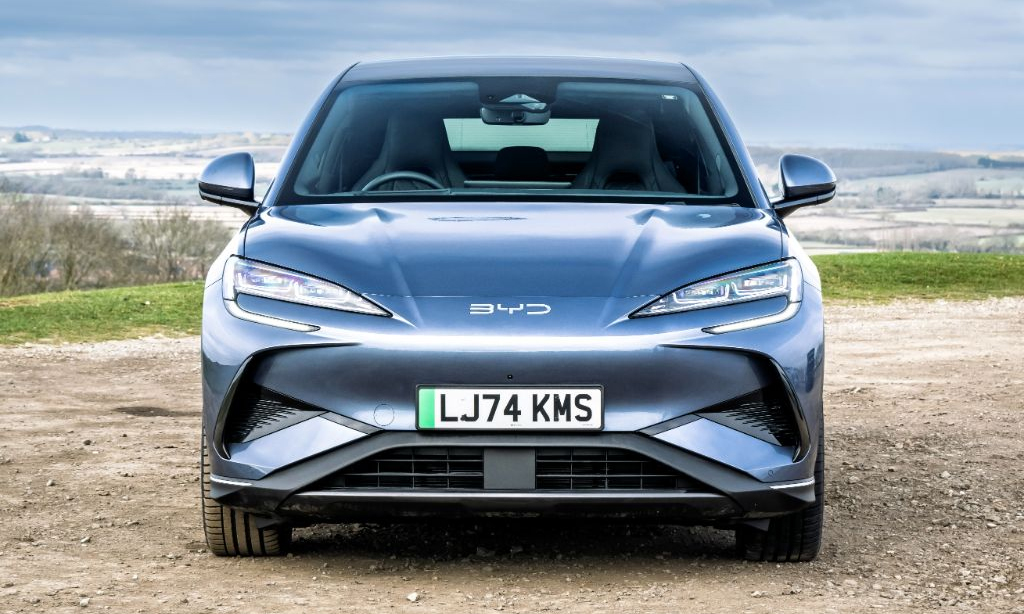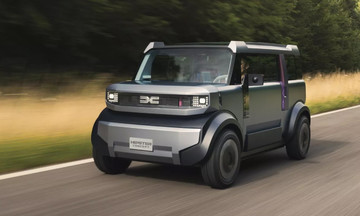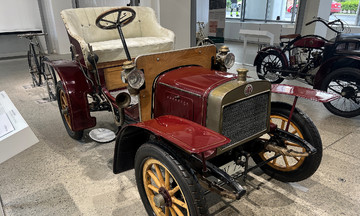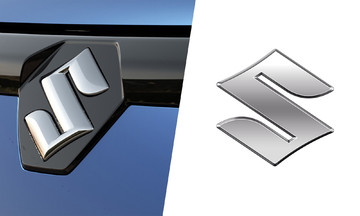According to data from the China Passenger Car Association (CPCA), the European market saw the largest surge, with hybrid imports from China jumping more than sixfold, while battery electric vehicle (BEV) imports decreased by 2%. Belgium, a major import hub for cars distributed throughout Europe, became the destination for the majority of these hybrid vehicles, even as Europe struggles with its ambitious zero-emission goal for 2035.
This abrupt shift by Chinese automakers, who control over half of the global electric vehicle demand with sales of 11 million vehicles annually, indicates the world isn't ready to abandon internal combustion engines, automakers and industry analysts told Rest of World.
 |
BYD Sealion 7 plug-in hybrid vehicle in the UK. Photo: Electrifying |
BYD Sealion 7 plug-in hybrid vehicle in the UK. Photo: Electrifying
Plug-in hybrid electric vehicles (PHEVs) emit about 30% less carbon than traditional gasoline-powered cars, according to International Energy Agency (IEA) estimates, but their use of fossil fuels could delay the global transition to zero emissions for years.
"We've witnessed a strategic shift by Chinese automakers to incorporate PHEVs into their export mix," said Bill Russo, CEO of Shanghai-based strategy and investment firm Automobility. "In markets where infrastructure or incentives for BEVs are weak, PHEVs offer a practical solution, allowing Chinese companies to compete on cost, range, and performance."
PHEVs account for nearly 33% of China's total electric vehicle exports. They have transformed what was once a purely electric export strategy into a multi-pronged one, helping to manage infrastructure limitations and consumer anxieties about running out of battery power.
Exports of PHEVs by major Chinese automaker BYD to Brazil, its largest overseas market, are now almost double those of its all-electric models. The company's rapid pivot reflects the agility Chinese automakers have developed to meet international market demands.
European trade policies have fueled this trend. While the European Union (EU) imposes additional tariffs on Chinese BEVs to protect domestic manufacturers, PHEVs escape these trade barriers, creating an unexpected loophole that Chinese companies are actively exploiting.
"The overall export growth of electric vehicles in the first half of the year was better than expected thanks to PHEVs and other hybrid vehicles," Cui Dongshu, secretary-general of the CPCA, said in a July market analysis report.
The charging infrastructure gap remains a fundamental driver of this shift. Markets from Southeast Asia to Latin America lack the necessary charging networks to support widespread adoption of battery-only vehicles, making hybrids an attractive option that addresses range anxiety while still offering some environmental benefits.
"If I only focused on producing electric cars, I would miss out on 50% of the new energy vehicle market," Vincent Wong, vice president of SAIC-GM-Wuling, said at the Gaikindo Indonesia International Auto Show in July. "PHEVs still have a place. The transition to BEVs really depends on the policies and ecosystems of different countries."
 |
The Wuling Xingguang S includes both BEV and PHEV versions, sold in China and exported to several global markets. Photo: Auto-in-china |
The Wuling Xingguang S includes both BEV and PHEV versions, sold in China and exported to several global markets. Photo: Auto-in-china
Japanese automakers pioneered the hybrid trend decades ago, with Toyota and Honda leading the way. Their traditional hybrids generate electricity while driving and braking, requiring no plug-in charging. Chinese companies entered much later with a different approach: plug-in hybrids that owners can charge at home or at charging stations, giving the cars a longer electric range before the gasoline engine kicks in.
China's push for hybrids coincides with waning global incentives for electric vehicles. In the US — where Chinese electric vehicles face a ban, and federal subsidies and tax credits for electric vehicles expire next month — the market remains dominated by Japanese, South Korean, and domestic manufacturers offering a variety of engine options.
According to Michael Dunne, former president of General Motors in Indonesia, who now runs the automotive consulting firm Dunne Insights, the current situation reflects market realities rather than ideological viewpoints.
"Most people are thinking, 'Will the world go all-electric or stay with gasoline?'" Dunne said. "The reality is, there's going to be a powertrain allocation depending on the customer, region, country, and income."
The surge in Chinese hybrid exports could last 3-5 years before battery technology and infrastructure catch up with ambition, Russo said. However, despite the current deviation, the long-term potential of electric vehicles remains vast, with the rise of hybrids being more tactical than strategic, he said.
"This is a transition phase, not a reversal. In the long run, the global trajectory is still towards zero-emission vehicles."
The EU's recent decision to extend compliance timelines for automakers to meet emissions targets reflects a growing acknowledgment that initial timelines were overly optimistic. This regulatory flexibility is enabling Chinese hybrids to gain market share while the infrastructure for pure electric vehicles develops.
However, some Chinese automakers remain committed to the all-electric vision. William Li, founder of Nio, is a prominent holdout, maintaining the company's exclusive focus on battery electric vehicles.
"If I could go back in time, I would also produce range-extended electric vehicles (REEVs) to make a profit," Li told the media on 1/8, a day after launching Nio's latest BEV model, the Onvo L90 SUV, in Hangzhou, China. "What I can do now is persevere until people are willing to buy BEVs in the future."
REEVs use a small internal combustion engine or generator to recharge the battery when it runs low, extending driving range beyond what the battery alone can provide. According to Chinese automotive market research firm Gasgoo, they represent another variation in China's diversified approach. These vehicles, along with hybrids, provide consumers with more choices between all-electric vehicles and traditional gasoline-powered cars.
The importance of the export market increases as Chinese automakers face consolidation pressures domestically. With slowing domestic growth and fierce competition, international expansion through any powertrain becomes essential. The surge in Chinese hybrid exports also challenges assumptions about the speed of the global energy transition. While governments worldwide maintain ambitious electrification targets, the reality is that consumers and infrastructure have lagged behind.
Data from Belgium and the broader European market demonstrates that Chinese automakers have found a regulatory sweet spot by producing vehicles clean enough to meet current standards, but practical enough to overcome infrastructure limitations.
Chinese automakers' flexibility in offering powertrain options gives them a distinct advantage. Unlike competitors focused on a single technology, Chinese companies can adjust their product mix to match local conditions and regulations.
Many Chinese automakers will continue to produce hybrids as long as demand remains, Wong said. China's consolidating domestic market has made export success critical, regardless of the technology used.
Predictions of rapid and widespread adoption of battery-only vehicles have given way to a more complex reality where multiple technologies will coexist for longer than anticipated, Dunne said. He noted that initial ambitions were perhaps overly idealistic.
"PHEVs are a bridge — they're better than pure gasoline," Dunne said. "The pace of electric vehicle development isn't as fast as some expected, but it's still headed in the right direction."
My Anh










